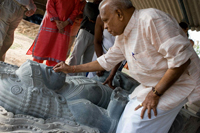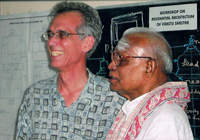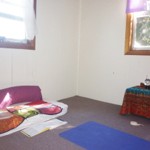By guest author Michael Borden
The structure of the Vastu inspired building vibrates with cosmic energy and the bodily instrument resonates with this vibration. To create and offer the house of supreme bliss, and to enable us to experience that supreme bliss here in this mundane house itself – these are the prime motives of Vastu Science. – Dr. V. Ganapati Sthapati
In the mid-1990s, I begun a search for information about Vastu Architecture. I found that there were many ancient and modern volumes dedicated to the subject. However, when I surveyed the books I found them quite confusing.
I realized that I needed to find a teacher, so in 1998 and 1999 I traveled toMadras, India, to study the principles of Vastu Science as applied to Architecture.
I was fortunate to find Dr. V. Ganapati Sthapati of Chennai.
Ganapati Sthapati was born in 1927 into a family whose ancestors built the great temple at Tanjore in the 10th century. He learned his craft from his father, Vaidyanatha Sthapati, a renowned traditional temple architect and sculptor. Vaidyanatha Sthapati was commissioned by Sri Ramana of Tiruvannamalai to design and build the Matrubhuteswara Temple, the Mother’s Shrine, at the ashram.
Starting out as a sculptor’s apprentice, he grew to become a master sculptor and a temple designer. He spent 27 years as head of the Government College of Architecture and Sculpture in Mahabalipuram, Tamil Nadu, a college founded by his father at the request of the Tamil Nadu government. He is responsible for India¹s significant resurgence in the ancient art of stone carving.
I first met Sthapati inKansas City. Our interview lasted about one hour. He said that architecture was frozen music and that a building could be an expression of pleasant and powerful harmonies. He spoke of the possibility of a building being a coherence generator, attuning the occupants to the laws of the universe and increasing health, wealth and spiritual well being.
He said that a building was a living organism, like the human nervous system, and could be designed in “harmonic resonance” with the basic underlying energy structure of the universe. But more than his words, his presence, his confidence, his enthusiasm and love of his art, told me that he was a man who lived his Truth.
There are many factors at work in the creation of a building aligned with principles of Vastu Science. I began studies with Ganapati Sthapati hoping that he would act as and interpreter and filter of the knowledge for me and this he did. I came away from my studies with a balanced and applicable body of knowledge.
In the heart cave of the body there is inner space and in that inner-space there is the vibrant thread of consciousness. It is this thread of consciousness that functions as the string of the sarira-vina (bodily instrument). – Dr. V. Ganapti Sthapati
The design regime for the Vastu architect follows specific parameters:
- orientation and siting considerations
- building layout with regard to a grid called “Vastu Purusha Mandala”
- dimensioning with regard to the client’s birth time and use of prescribed units of measure
- exterior door locations
- Brahmastan
- room placement
- building volume and height.
A significant element in a Vastu residence is the Brahamasthan or central courtyard. In a grid of 9 x 9 it is the center nine units. It is the energy heart of the house. It is the lung of the house. This part of the house should always be left open and free of obstructing elements (pillars or walls) and mechanical services. It is traditional, where climate permits, to leave the Brahmasthan open to the sky so that the energetic space surrounding the Earth is attracted into the house.
The selection of a building site is a very important factor in Vastu Architecture. The general slope of the site is very important. Level land or land sloping down to the east, northeast, north or northwest is considered to be beneficial with the opposite having negative effects for the occupants of the structure. Orientation of the structure with respect to the cardinal points of the compass is important. Correct orientation harmonizes the energy of the structure and occupants with that of the earth and celestial bodies.
Sthapati says:
This establishes a kind of geometric congruency or harmony with the earthly grid. If the structure’s grid is in harmony with the Earth’s grid, then the built space and the Earth respond harmoniously energetically. If there is any distortion, deviation or deflection in the grid lines of the proposed building grid and that of the Earth’s grid, then the built space is said to be in disharmony with the Earth’s energy grid system.
The Brahmasthan provides the occupants of the house with beneficial spiritual energy. Room location in the building is an important factor in Vaastu architecture. The location of a particular room defined by function is determined by respecting the particular element, earth, air, fire, water or space, that rules that area of the building.
All these principles (and more) give the architect a design protocol for creating buildings that live and vibrate harmoniously with universal energies. I am convinced that this information is worth study and application by anyone interested in understanding the significance and full potential of sheltering the human nervous system.
About Michael:
Michael Borden has post-graduate degrees in Architecture and Mayonic Science and Technology.
He has designed and built Vastu structures for the past 15 years worldwide.
Presently, he divides his time between the USA Midwest and New Zealand working on Vastu projects. You can contact him through email or via the Vastuved International Website. His own website is Vastu Design.




It is great to see this straightforward article here. Michael Borden is one of the world’s leading Vaastu architects. His knowledge base is deep and profound. there are only a handfull of authentic Vaastu consultants/architects living today.
Hello Dr. Mercay,
It is wonderful to have Michael on the website. We are very fortunate.
Blessings,
KL